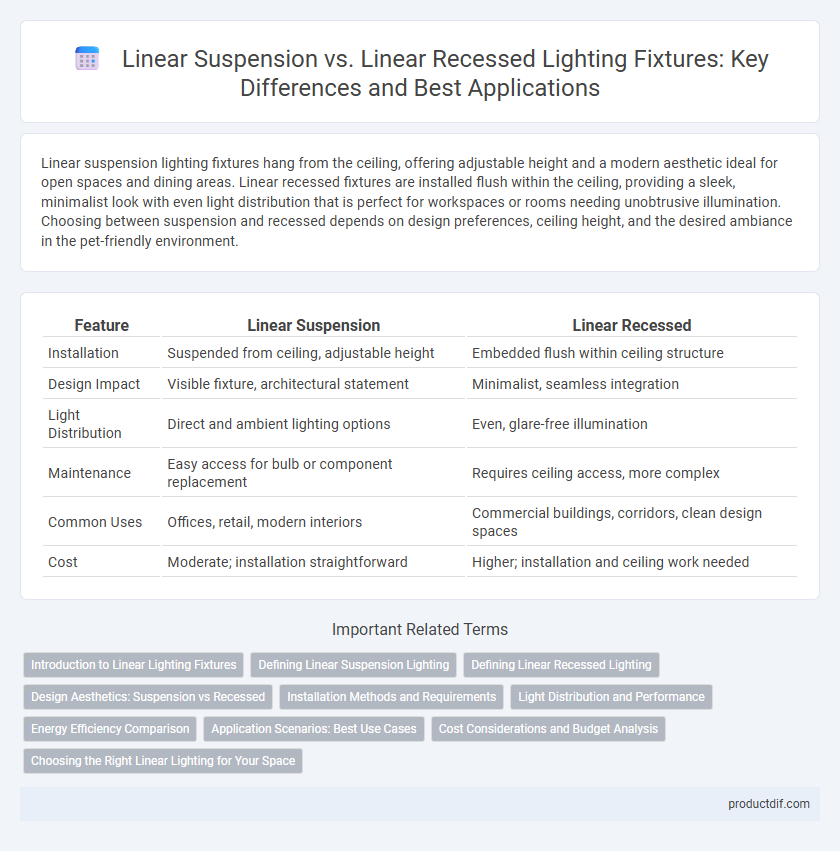Linear suspension lighting fixtures hang from the ceiling, offering adjustable height and a modern aesthetic ideal for open spaces and dining areas. Linear recessed fixtures are installed flush within the ceiling, providing a sleek, minimalist look with even light distribution that is perfect for workspaces or rooms needing unobtrusive illumination. Choosing between suspension and recessed depends on design preferences, ceiling height, and the desired ambiance in the pet-friendly environment.
Table of Comparison
| Feature | Linear Suspension | Linear Recessed |
|---|---|---|
| Installation | Suspended from ceiling, adjustable height | Embedded flush within ceiling structure |
| Design Impact | Visible fixture, architectural statement | Minimalist, seamless integration |
| Light Distribution | Direct and ambient lighting options | Even, glare-free illumination |
| Maintenance | Easy access for bulb or component replacement | Requires ceiling access, more complex |
| Common Uses | Offices, retail, modern interiors | Commercial buildings, corridors, clean design spaces |
| Cost | Moderate; installation straightforward | Higher; installation and ceiling work needed |
Introduction to Linear Lighting Fixtures
Linear lighting fixtures provide sleek, continuous illumination ideal for modern architectural designs. Linear suspension fixtures hang from ceilings, offering versatile placement and striking visual appeal in commercial and residential spaces. Linear recessed fixtures are integrated flush with surfaces, delivering seamless light distribution while maintaining a minimalist aesthetic in offices, retail areas, and corridors.
Defining Linear Suspension Lighting
Linear suspension lighting features fixtures suspended from the ceiling by cords or rods, providing versatile illumination ideal for commercial and residential spaces. These fixtures offer customizable lengths and styles, enhancing design flexibility while delivering direct or ambient light. Unlike linear recessed lighting, linear suspension creates a focal point with its visible hardware and suspended form factor.
Defining Linear Recessed Lighting
Linear recessed lighting integrates seamlessly into ceilings or walls, offering a sleek, minimalistic appearance with illumination directly embedded within architectural surfaces. Unlike linear suspension fixtures that hang from the ceiling, linear recessed fixtures provide uniform, glare-free light while maximizing spatial aesthetics and maintaining a clean ceiling line. Ideal for modern commercial and residential designs, linear recessed lighting enhances ambient and task lighting without compromising interior design flow.
Design Aesthetics: Suspension vs Recessed
Linear suspension fixtures create a striking visual impact by hanging from the ceiling, offering sculptural design elements and enhancing spatial depth. Linear recessed fixtures provide a sleek, minimalist aesthetic by integrating seamlessly into the ceiling, maintaining clean lines and a clutter-free look. Both options optimize lighting distribution, but suspension fixtures emphasize architectural presence while recessed fixtures prioritize unobtrusive elegance.
Installation Methods and Requirements
Linear suspension lighting fixtures hang from the ceiling using cables or rods, requiring ceiling anchors and precise height adjustments to ensure stability and alignment. Linear recessed fixtures are installed flush within ceiling cavities, demanding accurate ceiling cutouts and integration with the architectural structure for a seamless, built-in appearance. Both installation methods necessitate electrical wiring considerations, but recessed fixtures typically require coordination with HVAC and ceiling grid systems due to their embedded placement.
Light Distribution and Performance
Linear suspension fixtures offer versatile light distribution, creating an even, ambient glow ideal for open spaces and contemporary designs. Linear recessed fixtures provide more focused, direct illumination by integrating seamlessly into ceilings, enhancing visual comfort with minimal glare. Performance-wise, suspended models excel in adjustable height and aesthetic appeal, while recessed options deliver energy-efficient, crisp lighting suitable for task-oriented environments.
Energy Efficiency Comparison
Linear suspension lighting fixtures generally offer higher energy efficiency due to their direct downward illumination, reducing wasted light and lowering wattage requirements. Linear recessed fixtures often require additional reflectors and diffusers, which can decrease luminous efficacy by scattering light and causing energy loss. Selecting linear suspension fixtures optimized with LED technology can result in significant energy savings compared to traditional linear recessed options.
Application Scenarios: Best Use Cases
Linear suspension fixtures excel in open office spaces, retail environments, and modern residential areas where design aesthetics and adjustable height are crucial. Linear recessed lighting is ideal for commercial corridors, conference rooms, and minimalist interiors requiring seamless integration with ceilings and uniform illumination. Selecting between the two depends on spatial dynamics, desired ambiance, and functional lighting needs.
Cost Considerations and Budget Analysis
Linear suspension fixtures typically incur higher upfront costs due to complex installation and hardware requirements, whereas linear recessed lighting often demands additional ceiling modifications that can increase labor expenses. Budget analysis should account for long-term maintenance costs, with linear recessed options generally offering easier access for bulb replacement and lower replacement frequency. Selecting between the two depends on balancing initial expenditure against ongoing operational costs within the project's financial constraints.
Choosing the Right Linear Lighting for Your Space
Linear suspension lighting offers versatile placement and adds a modern aesthetic with adjustable hanging heights, ideal for open spaces and high ceilings. Linear recessed fixtures provide a sleek, integrated look that blends seamlessly into ceilings, perfect for minimalist designs and areas requiring unobtrusive illumination. Selecting the right linear lighting depends on room size, ceiling height, design preference, and desired light distribution intensities.
Linear Suspension vs Linear Recessed Infographic

 productdif.com
productdif.com